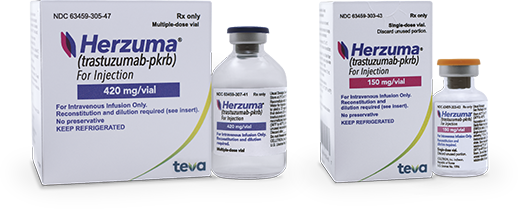INDICATIONS
Adjuvant Breast Cancer
HERZUMA is indicated in adults for the adjuvant treatment of HER2-overexpressing node-positive or node-negative (ER/PR negative or with one high-risk feature) breast cancer
- as part of a treatment regimen consisting of doxorubicin, cyclophosphamide, and either paclitaxel or docetaxel
- as part of a treatment regimen with docetaxel and carboplatin
- as a single agent following multi-modality anthracycline based therapy
Select patients for therapy based on an FDA-approved companion diagnostic for a trastuzumab product
Metastatic Breast Cancer
HERZUMA is indicated in adults:
- In combination with paclitaxel for first-line treatment of HER2-overexpressing metastatic breast cancer
- As a single agent for treatment of HER2-overexpressing breast cancer in patients who have received one or more chemotherapy regimens for metastatic disease
Select patients for therapy based on an FDA-approved companion diagnostic for a trastuzumab product
Metastatic Gastric Cancer
HERZUMA is indicated in adults, in combination with cisplatin and capecitabine or 5-fluorouracil, for the treatment of patients with HER2-overexpressing metastatic gastric or gastroesophageal junction adenocarcinoma who have not received prior treatment for metastatic disease
Select patients for therapy based on an FDA-approved companion diagnostic for a trastuzumab product
IMPORTANT SAFETY INFORMATION
BOXED WARNINGS
WARNING: CARDIOMYOPATHY, INFUSION REACTIONS, EMBRYO FETAL TOXICITY, AND PULMONARY TOXICITY
Cardiomyopathy - Administration of trastuzumab products can result in sub-clinical and clinical cardiac failure. The incidence and severity was highest in patients receiving trastuzumab with anthracycline containing chemotherapy regimens.
Evaluate left ventricular function in all patients prior to and during treatment with HERZUMA. Discontinue HERZUMA treatment in patients receiving adjuvant therapy and withhold HERZUMA in patients with metastatic disease for clinically significant decrease in left ventricular function.
Infusion Reactions; Pulmonary Toxicity - Administration of trastuzumab products can result in serious and fatal infusion reactions and pulmonary toxicity. Symptoms usually occur during or within 24 hours of administration of trastuzumab products. Interrupt HERZUMA infusion for dyspnea or clinically significant hypotension. Monitor patients until symptoms completely resolve. Discontinue HERZUMA for anaphylaxis, angioedema, interstitial pneumonitis, or acute respiratory distress syndrome.
Embryo-Fetal Toxicity - Exposure to trastuzumab products during pregnancy can result in oligohydramnios and oligohydramnios sequence manifesting as pulmonary hypoplasia, skeletal abnormalities, and neonatal death. Advise patients of these risks and the need for effective contraception.
Warnings and Precautions
Cardiomyopathy
- Administration of trastuzumab products can result in sub-clinical and clinical cardiac failure. The incidence and severity was highest in patients receiving trastuzumab with anthracycline containing chemotherapy regimens
- Trastuzumab products can cause left ventricular cardiac dysfunction, arrhythmias, hypertension, disabling cardiac failure, cardiomyopathy, and cardiac death
- Trastuzumab products can also cause asymptomatic decline in left ventricular ejection fraction (LVEF)
- Discontinue HERZUMA treatment in patients receiving adjuvant therapy and withhold HERZUMA in patients with metastatic disease for clinically significant decrease in left ventricular function
- The safety of continuation or resumption of HERZUMA in patients with trastuzumab product-induced LV cardiac dysfunction has not been studied
Cardiac Monitoring
- Evaluate cardiac function prior to and during treatment, including history, physical examination, and determination of LVEF by echocardiogram or MUGA scan
- Conduct Baseline LVEF measurement immediately prior to initiation of HERZUMA
- Conduct LVEF measurements every 3 months during and upon completion of HERZUMA
- Repeat LVEF measurement at 4 week intervals if HERZUMA is withheld for significant left ventricular cardiac dysfunction
- LVEF measurements every 6 months for at least 2 years following completion of HERZUMA as a component of adjuvant therapy.
Infusion Reactions
- Administration of trastuzumab products can result in serious and fatal infusion reactions
- Symptoms usually occur during or within 24 hours of administration
- Interrupt HERZUMA infusion for dyspnea or clinically significant hypotension
- Monitor patients until symptoms completely resolve
- Discontinue HERZUMA for anaphylaxis or angioedema. Strongly consider permanent discontinuation in all patients with severe infusion reactions
- Infusion reactions consist of a symptom complex characterized by fever and chills, and on occasion included nausea, vomiting, pain (in some cases at tumor sites), headache, dizziness, dyspnea, hypotension, rash, and asthenia
Embryo-Fetal Toxicity
- Exposure to trastuzumab products during pregnancy can result in oligohydramnios and oligohydramnios sequence manifesting as pulmonary hypoplasia, skeletal abnormalities, and neonatal death. Advise patients of these risks and the need for effective contraception
- Verify the pregnancy status of females of reproductive potential prior to the initiation of HERZUMA
- Advise pregnant women and females of reproductive potential that exposure to HERZUMA during pregnancy or within 7 months prior to conception can result in fetal harm
- Advise females of reproductive potential to use effective contraception during treatment and for 7 months following the last dose of HERZUMA. Advise female patients to contact their healthcare provider with a known or suspected pregnancy
- Consider the developmental and health benefits of breastfeeding along with the mother’s clinical need for HERZUMA treatment and any potential adverse effects on the breastfed child from HERZUMA or from the underlying maternal condition
Pulmonary Toxicity
- Administration of trastuzumab products can result in serious and fatal pulmonary toxicity, which includes dyspnea, interstitial pneumonitis, pulmonary infiltrates, pleural effusions, non cardiogenic pulmonary edema, pulmonary insufficiency and hypoxia, acute respiratory distress syndrome, and pulmonary fibrosis. Such events can occur as sequelae of infusion reactions
- Patients with symptomatic intrinsic lung disease or with extensive tumor involvement of the lungs, resulting in dyspnea at rest, appear to have more severe toxicity
- Discontinue HERZUMA in patients experiencing pulmonary toxicity
Exacerbation of Chemotherapy-Induced Neutropenia
- In randomized, controlled clinical trials, the per-patient incidences of NCI-CTC Grade 3 to 4 neutropenia and of febrile neutropenia were higher in patients receiving trastuzumab in combination with myelosuppressive chemotherapy as compared to those who received chemotherapy alone. The incidence of septic death was similar among patients who received trastuzumab and those who did not
Most Common Adverse Reactions
Adjuvant Breast Cancer
- Most common adverse reactions (≥5%) are headache, diarrhea, nausea, and chills
Metastatic Breast Cancer
- Most common adverse reactions (≥10%) are fever, chills, headache, infection, congestive heart failure, insomnia, cough, and rash
Metastatic Gastric Cancer
- Most common adverse reactions (≥10%) are neutropenia, diarrhea, fatigue, anemia, stomatitis, weight loss, upper respiratory tract infections, fever, thrombocytopenia, mucosal inflammation, nasopharyngitis, and dysgeusia
Please click here for full Prescribing Information for HERZUMA, including BOXED WARNINGS.
You may report side effects to Teva at 1-888-483-8279. You may also report side effects to 1-800-FDA-1088 or www.fda.gov/medwatch.
Embryo-Fetal Toxicity
- Exposure to trastuzumab products during pregnancy can result in oligohydramnios and oligohydramnios sequence manifesting as pulmonary hypoplasia, skeletal abnormalities, and neonatal death. Advise patients of these risks and the need for effective contraception
- Verify the pregnancy status of females of reproductive potential prior to the initiation of HERZUMA
- Advise pregnant women and females of reproductive potential that exposure to HERZUMA during pregnancy or within 7 months prior to conception can result in fetal harm
- Advise females of reproductive potential to use effective contraception during treatment and for 7 months following the last dose of HERZUMA. Advise female patients to contact their healthcare provider with a known or suspected pregnancy
- Consider the developmental and health benefits of breastfeeding along with the mother’s clinical need for HERZUMA treatment and any potential adverse effects on the breastfed child from HERZUMA or from the underlying maternal condition
Pulmonary Toxicity
- Administration of trastuzumab products can result in serious and fatal pulmonary toxicity, which includes dyspnea, interstitial pneumonitis, pulmonary infiltrates, pleural effusions, non cardiogenic pulmonary edema, pulmonary insufficiency and hypoxia, acute respiratory distress syndrome, and pulmonary fibrosis. Such events can occur as sequelae of infusion reactions
- Patients with symptomatic intrinsic lung disease or with extensive tumor involvement of the lungs, resulting in dyspnea at rest, appear to have more severe toxicity
- Discontinue HERZUMA in patients experiencing pulmonary toxicity
Exacerbation of Chemotherapy-Induced Neutropenia
- In randomized, controlled clinical trials, the per-patient incidences of NCI-CTC Grade 3 to 4 neutropenia and of febrile neutropenia were higher in patients receiving trastuzumab in combination with myelosuppressive chemotherapy as compared to those who received chemotherapy alone. The incidence of septic death was similar among patients who received trastuzumab and those who did not
Most Common Adverse Reactions
Adjuvant Breast Cancer
- Most common adverse reactions (≥5%) are headache, diarrhea, nausea, and chills
Metastatic Breast Cancer
- Most common adverse reactions (≥10%) are fever, chills, headache, infection, congestive heart failure, insomnia, cough, and rash
Metastatic Gastric Cancer
- Most common adverse reactions (≥10%) are neutropenia, diarrhea, fatigue, anemia, stomatitis, weight loss, upper respiratory tract infections, fever, thrombocytopenia, mucosal inflammation, nasopharyngitis, and dysgeusia
Please click here for full Prescribing Information for HERZUMA, including BOXED WARNINGS.
You may report side effects to Teva at 1-888-483-8279. You may also report side effects to FDA at 1-800-FDA-1088 or www.fda.gov/medwatch.

 DOSING ADMINISTRATION
DOSING ADMINISTRATION
